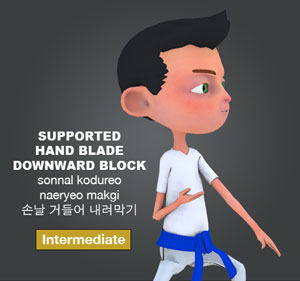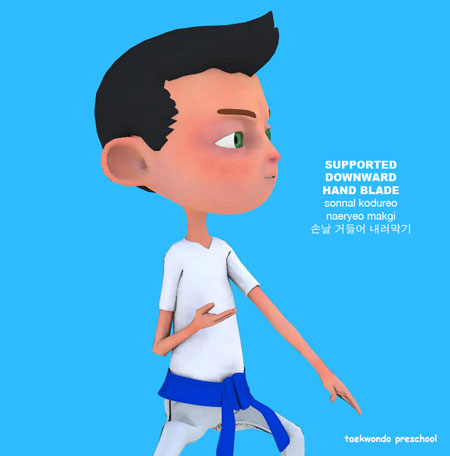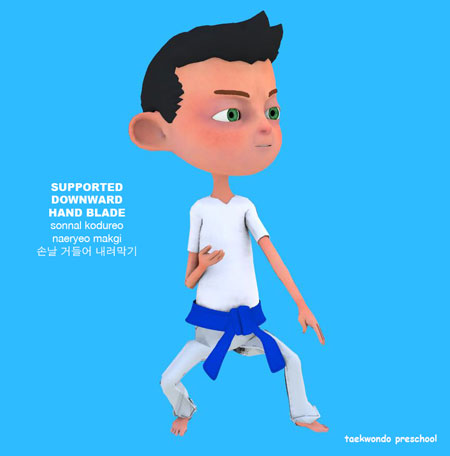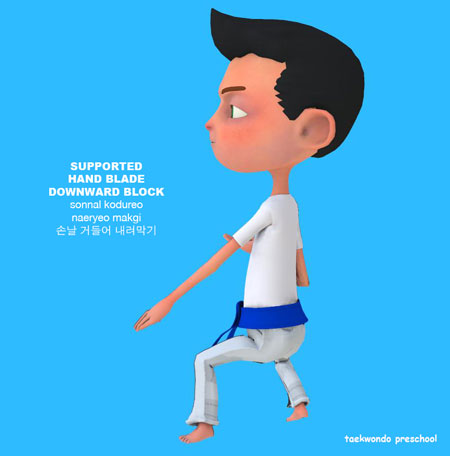- Kids Preschool
- About Blocks ( 막기 makgi )
- Supported Hand Blade Downward Block ( 손날 거들어 내려막기 sonnal-kodureo-naeryeo-makgi )
Taekwondo 태권도Taekwondo Preschool
Promotion from one geup to the next can proceed rapidly in some schools, since schools often allow geup promotions every two, three, or four months. Students of geup rank learn the most basic techniques first, and then move on to more advanced techniques as they approach first dan. Many of the older and more traditional schools often take longer to allow students to test for higher ranks than newer, more contemporary schools, as they may not have the required testing intervals. View Taekwondo belt levels »


Supported Hand Blade Downward Block
( 손날 거들어 내려막기 sonnal-kodureo-naeryeo-makgi )
Difficulty Level: Intermediate Technique: Blocks ( 막기 makgi )
The Supported Hand Blade Downward Block ( 손날 거들어 내려막기 sonnal-kodureo-naeryeo-makgi ) is an intermediate blocking technique where you make a low block ( 아래막기 arae-makgi ) with hand blades ( 손날 sonnal ), while the other hand ( 손 son ) is supporting the block ( 막기 makgi ) also with hand blades ( 손날 sonnal ) around the sternum area.
The blocking hand ( 손 son ) starts from shoulder level with the palm ( 손바닥 sonbadak ) up while you stretch the other hand ( 손 son ) far from the waist reaching outwards with the palm ( 손바닥 sonbadak ) facing downward at shoulder height level. Both hands ( 손 son ) should be completed at the same time but not one after another when executing the block ( 막기 makgi ).
The supporting hand ( 손 son ) could be used as a counter strike such as with the Palm Heel Forward Strike ( 바탕손 앞치기 batangson-ap-chigi ), Spearhand Vertical Thrust ( 편손끝 세워찌르기 pyeonsonkkeut-sewo-jjireugi ), or the Flat Fingertips Horizontal Strike ( 편손끝 엎어찌르기 pyeonsonkkeut-eopeo-jjireugi ).
In the final form, the blocking arm's elbow ( 팔굽 palgup ) and the supporting hand ( 손 son ) should not be touching each other. The front blocking hand blades ( 손날 sonnal ) is set above the thigh roughly two-fist gap distance most commonly in a Back Stance ( 뒷굽이 dwi-kubi ). The supporting hand ( 손 son ) is placed one fist below the solar plexus with the wrist ( 팔목 palmok ) aligned to the center of body. Remember to keep the wrists ( 팔목 palmok ) straight.
* Please see a certified Master Instructor ( 사범님 sabeomnim ) for training. Proper guidance and instructions are needed to ensure safe training.




Did you know?
Southeast Asian Games Championships
The Southeast Asian Games (also known as the SEA Games), is a biennial multi-sport event involving participants from the current 11 countries of Southeast Asia. The games is under regulation of the Southeast Asian Games Federation with supervision by the International Olympic Committee (IOC) and the Olympic Council of Asia. For more information View Southeast Asian Games Championships »
| Year | Date | Flag | City and Host Country | Place |
| 2019 | November 30 - December 10 |  |
Various | Philippines |
| 2017 | August 19 - August 30 |  |
Kuala Lumpur | Malaysia |
| 2015 | June 5 - June 16 |  |
Singapore | Singapore |
| 2013 | December 11 - December 22 |  |
Naypyidaw | Myanmar |
| 2011 | November 11 - November 22 |  |
Palembang and Jakarta | Indonesia |
| 2009 | December 9 - December 18 |  |
Vientiane | Laos |
| 2007 | December 6 - December 15 |  |
Nakhon Ratchasima | Thailand |
| 2005 | November 27 - December 5 |  |
Manila | Philippines |
| 2003 | December 5 - December 13 |  |
Hanoi | Vietnam |
RESOURCES
This article uses material from the Wikipedia article "Southeast Asian Games" which is released under the Creative Commons Attribution-Share-Alike License 3.0.

Quiz
Question. In what year was the World Taekwondo Federation (WTF) officially established?
The World Taekwondo Federation is the International Federation [IF] governing the sport of Taekwondo and is a member of the Association of Summer Olympic International Federations [ASOIF]. The WTF was established at its inaugural meeting held at the Kukkiwon ( 국기원 ) with participation of 35 representatives from the world and until this day there is a total of 205 Member Nations. The World Taekwondo Federation (WTF) has renamed itself to World Taekwondo (WT) in 2017.
Question. In what year was the World Taekwondo Federation (WTF) officially established?
Answer you gave was: 1971
Your answer is wrong! You need to study more!

The World Taekwondo Federation (WTF) was established on May 28, 1973 (Renamed itself to World Taekwondo (WT) in 2017). According to the WTF, "Taekwondo is one of the most systematic and scientific Korean traditional martial arts, that teaches more than physical fighting skills. It is a discipline that shows ways of enhancing our spirit and life through training our body and mind". Today, it has become a global sport that has gained an international reputation, and stands among the official games in the Olympics.
Question. In what year was the World Taekwondo Federation (WTF) officially established?
Answer you gave was: 1973
Your answer is correct! Great Job!

The World Taekwondo Federation (WTF) was established on May 28, 1973 (Renamed itself to World Taekwondo (WT) in 2017). According to the WTF, "Taekwondo is one of the most systematic and scientific Korean traditional martial arts, that teaches more than physical fighting skills. It is a discipline that shows ways of enhancing our spirit and life through training our body and mind". Today, it has become a global sport that has gained an international reputation, and stands among the official games in the Olympics.
Question. In what year was the World Taekwondo Federation (WTF) officially established?
Answer you gave was: 1975
Your answer is wrong! You need to study more!

The World Taekwondo Federation (WTF) was established on May 28, 1973 (Renamed itself to World Taekwondo (WT) in 2017). According to the WTF, "Taekwondo is one of the most systematic and scientific Korean traditional martial arts, that teaches more than physical fighting skills. It is a discipline that shows ways of enhancing our spirit and life through training our body and mind". Today, it has become a global sport that has gained an international reputation, and stands among the official games in the Olympics.
Question. In what year was the World Taekwondo Federation (WTF) officially established?
Answer you gave was: 1977
Your answer is wrong! You need to study more!

The World Taekwondo Federation (WTF) was established on May 28, 1973 (Renamed itself to World Taekwondo (WT) in 2017). According to the WTF, "Taekwondo is one of the most systematic and scientific Korean traditional martial arts, that teaches more than physical fighting skills. It is a discipline that shows ways of enhancing our spirit and life through training our body and mind". Today, it has become a global sport that has gained an international reputation, and stands among the official games in the Olympics.
Question. What is the name of Taegeuk #3 in Korean?
Taegeuk 태극 (in World Taekwondo (WT)) refers to a set of poomse 품새 used to create a foundation for the teaching of taekwondo. A poomse or form is a detailed pattern of defense-and-attack motions and techniques used in traditional martial arts. Each taegeuk form symbolizes a specific state thought to be indicative of the belt the student currently holds, and is represented in World Taekwondo (WT) by trigrams similar to those found in the four corners of the South Korean flag.
Question. What is the name of Taegeuk #3 in Korean?
Answer you gave was: Chil Jang
Your answer is wrong! You need to study more!


The trigram associated with this poomse represents a Mountain. Also, it represents the northwest and youngest son. The symbolism behind the mountain is the indomitable and majestic nature that all mountains possess. This poomse is intended to be performed with the feeling that all movements are this majestic due to their unconquerable nature.
Question. What is the name of Taegeuk #3 in Korean?
Answer you gave was: Sam Jang
Your answer is correct! Great Job!


This trigram represents Fire. Related to this symbol is also East and the relationship of the Second Daughter. Fire contains a lot of energy. The symbol behind the fire is similar to the symbolism of the water in that both can aid and both can destroy. This form is intended to be performed rhythmically, with some outbursts of energy to reflect fire's rhythmic and energetic dualism.
Question. What is the name of Taegeuk #3 in Korean?
Answer you gave was: Yi Jang
Your answer is wrong! You need to study more!


The associated trigram of this poomse represents the Lake. Also, related to the symbol is South East and the relationship of the youngest daughter. The movements of this Taegeuk are aimed to be performed believing that man has limitations, but that we can overcome these limitations. The Lake and its water symbolize the flowing and calm nature of the martial artist.
Question. What is the name of Taegeuk #3 in Korean?
Answer you gave was: Sa Jang
Your answer is wrong! You need to study more!


This trigram represents Thunder. Also, the trigram is strongly connected to northeast and the relationship of the Eldest son. Thunder comes from the sky and is absorbed by the earth, thus, according to the beliefs of the I Ching, thunder is one of the most powerful natural forces. This poomse is associated with power and the connection between the heavens and earth.
Question. What is the korean terminology for Front Stance?
Front Stance is a precursor of the fighting stance ( 겨루기준비 gyeorugi-junbi ) according to some martial arts authors. Body should be relaxed in this stance ( 서기 sogi ) when performed in patterns ( 품새 poomse ) and self-defense ( 호신술 hosinsool ). Although the specifics of the stance vary by style, overall it is visually similar to a lunge, with the forward leg bent at the knee, and the rear leg straight, while the hips and shoulders remain squarely facing forward.
Question. What is the korean terminology for Front Stance?
Answer you gave was: ( 뒷굽이 dwi kubi )
Your answer is wrong! You need to study more!

Back Stance ( 뒷굽이 dwi kubi ) is specifically focused on shifting weight to the back leg, as it offers much more control, and makes it easier to kick off the front leg. To perform the Back Stance ( 뒷굽이 dwi-kubi ), the body faces to the side, with the front foot facing forward and the front leg bent. The back leg is bent slightly and the foot is turned outwards perpendicular to the front foot making the letter "L" for this stance ( 서기 sogi ).
Question. What is the korean terminology for Front Stance?
Answer you gave was: ( 주춤서기 juchum sogi )
Your answer is wrong! You need to study more!

The Horse-Riding Stance ( 주춤서기 juchum-sogi ) is a beginner stance ( 서기 sogi ) generally used to practice punches ( 지르기 jireugi ) and blocks ( 막기 makgi ). It is similar to the Ready Stance ( 기본준비 junbi ) but the feet are placed much wider, about two-foot length's apart. Also, the knees ( 무릎 mureup ) are deeply bent and the shins ( 정강이 jeonggangi ) should be kept slightly perpendicular to the floor.
Question. What is the korean terminology for Front Stance?
Answer you gave was: ( 앞굽이 ap kubi )
Your answer is correct! Great Job!

Front Stance ( 앞굽이 ap-kubi ) is one of the most important techniques to learn when starting taekwondo as a beginner. The distance between the inside edges or namely the Reverse Foot Blade ( 발날등 balnaldeung ) of both feet should be between one to two fists apart and is about 4 to 4 one-half foot-length from origin. Rear toes are turned outward about 30 degrees and the body is also naturally angled at 30 degrees or facing straight forward depending on the upper body technique.
Question. What is the korean terminology for Front Stance?
Answer you gave was: ( 앞서기 ap sogi )
Your answer is wrong! You need to study more!

The Walking Stance ( 앞서기 ap-sogi ) is a beginner stance ( 서기 sogi ) that is used to approach or retreat in combat and patterns ( 품새 poomse ). Feet should be maintained approximately 3 foot-length from origin. To maintain a solid base, the front foot is facing straight forward and the back foot is 30 degrees to aid balance. Use of this stance ( 서기 sogi ) is featured prominently in many of the World Taekwondo (WT) Poomse.
There are five tenets defined in the International Taekwondo Federation (ITF) and several more in World Taekwondo (WT).
Courtesy ( Ye Ui / 예의 ): "Showing courtesy to all, respecting others, having manners as well as maintaining the appropriate etiquette at all times, both within and outside the dojang (도장) (designated training area)." View Taekwondo Tenets »
RESOURCES
This article uses material from the Wikipedia article "List of Taekwondo Techniques", which is released under the Creative Commons Attribution-Share-Alike License 3.0.








